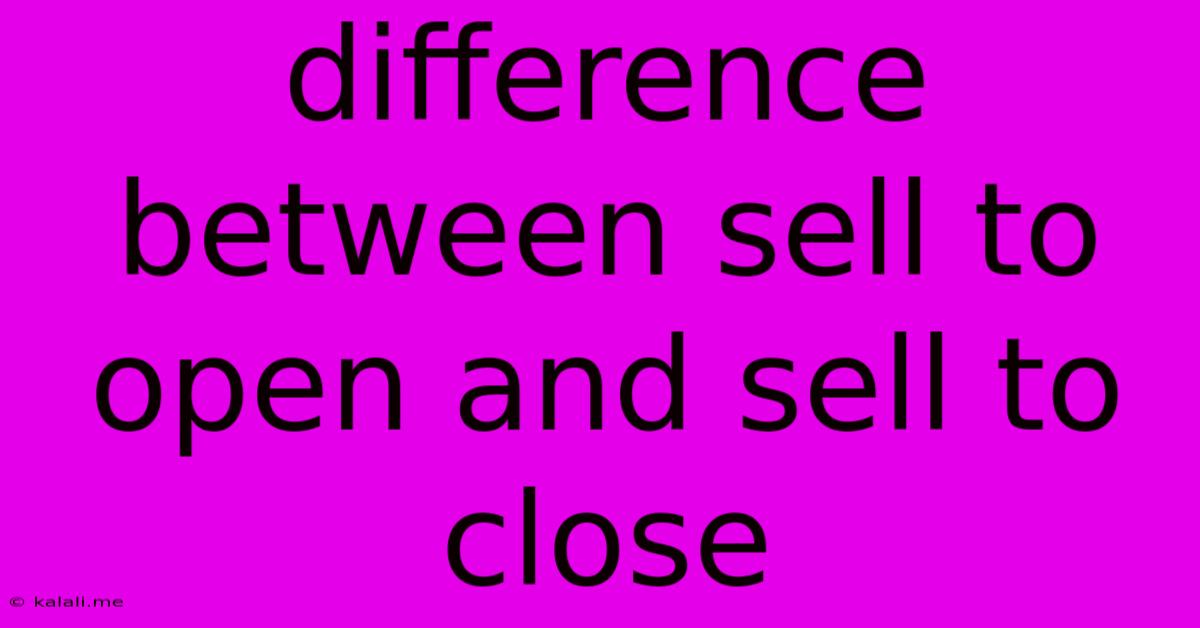Difference Between Sell To Open And Sell To Close
Kalali
Jun 02, 2025 · 3 min read

Table of Contents
Sell to Open vs. Sell to Close: Understanding the Key Differences in Options Trading
Options trading can be complex, and understanding the nuances of different order types is crucial for success. Two common order types, "sell to open" and "sell to close," often confuse beginners. This article clarifies the distinctions between these two strategies, outlining their purposes, risks, and potential rewards. Understanding these differences is vital for managing risk and maximizing profit in options trading.
What is a Sell to Open Order?
A sell to open (STO) order initiates a new short options position. This means you're selling an option contract that you don't currently own, expecting the underlying asset's price to move in a specific direction. Effectively, you're creating an obligation to either buy or sell the underlying asset at a predetermined price (the strike price) if the option is exercised.
- Profit Potential: Your profit is capped at the premium you receive when selling the option. This is because if the option expires worthless, you keep the premium.
- Risk: Your maximum loss is theoretically unlimited for options like covered calls (if the underlying price moves significantly against your position) or potentially large for uncovered options (naked calls). The risk stems from being obligated to fulfill the contract if the buyer exercises it. Proper risk management through strategies like hedging is crucial.
- When to Use: This strategy is used when you believe the price of the underlying asset will remain relatively stable or even decrease (for a put option) before the option expires.
What is a Sell to Close Order?
A sell to close (STC) order liquidates an existing long options position. This means you're selling an option contract that you already own, thereby closing out your position. You're essentially reversing your initial trade.
- Profit Potential: Your profit is the difference between the premium you paid to acquire the option and the premium you receive when selling it. This profit can be substantial if the option's price has increased.
- Risk: Your maximum loss is limited to the initial premium you paid to buy the option. This is because you can't lose more than what you initially invested.
- When to Use: This strategy is used to realize a profit on an option that has increased in value or to limit potential losses on a declining option.
Key Differences Summarized:
| Feature | Sell to Open (STO) | Sell to Close (STC) |
|---|---|---|
| Position Type | Opens a new short position | Closes an existing long position |
| Initial Action | Selling an option you don't own | Selling an option you own |
| Profit Potential | Limited to the premium received | Difference between buy and sell price |
| Maximum Loss | Potentially unlimited | Limited to initial premium paid |
| Market Outlook | Neutral to bearish (puts) / neutral to bullish (calls) | Bullish (when profitable) |
Example Scenarios:
- STO: You believe the price of XYZ stock will stay below $100 in the next month. You sell a call option with a strike price of $105, collecting a premium. If the price stays below $105, the option expires worthless, and you keep the premium.
- STC: You bought a call option on XYZ stock at a premium of $2 and the price is now $5. To secure your profit, you sell to close this option, realizing a $3 profit ($5 - $2).
Conclusion:
Understanding the distinction between "sell to open" and "sell to close" is fundamental to successful options trading. Choosing the correct order type depends on your market outlook, risk tolerance, and overall trading strategy. Always conduct thorough research and consider consulting a financial advisor before engaging in options trading. Remember, options trading involves significant risk and may not be suitable for all investors.
Latest Posts
Latest Posts
-
Mass Effect 3 Cant Get Past Level Vii
Jun 04, 2025
-
Hellsing Alucard Tattoo Volume 1 Cover
Jun 04, 2025
-
Does A Tree Make A Sound When It Falls
Jun 04, 2025
-
How To Solve Riccati Equation In Optimal Control
Jun 04, 2025
-
Does A Refrigerator Need A Gfci
Jun 04, 2025
Related Post
Thank you for visiting our website which covers about Difference Between Sell To Open And Sell To Close . We hope the information provided has been useful to you. Feel free to contact us if you have any questions or need further assistance. See you next time and don't miss to bookmark.